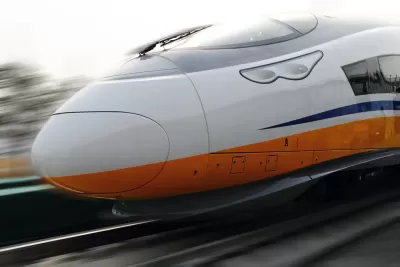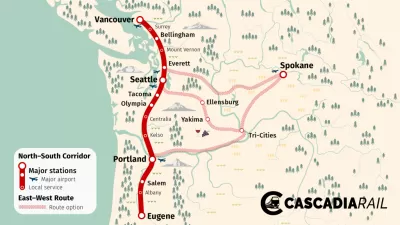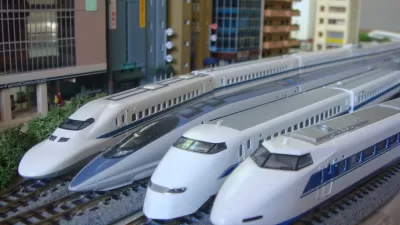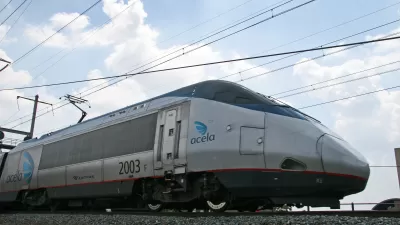High-speed rail advocates in the Pacific Northwest are pushing for a high-speed link between Vancouver, Seattle, and Portland to be part of future economic stimulus spending in the United States.

Martin Brosnan writes to anticipate and plan for economic recovery, returning to an idea that figured in the economic recovery plan for the previous recession, yet without much to show for it: high-speed rail.
After dispensing with the idea of repeating the mistakes of the country's history of car-centric economic stimulus spending, Brosnan suggests high-speed rail as a desirable approach to an infrastructure related economic stimulus:
High-speed rail, however, may be the way to go. A high-speed rail line from Portland, Oregon to Vancouver, British Columbia is the perfect project to provide hundreds of short- and long-term employment opportunities, stimulate the economy of one of North America’s top 10 most populated mega-regions, foster increased cooperation between the two nations post border-closure, and to help move people through the region and to new employment opportunities in an economy that may result in fewer people being able to afford personal vehicles. Looking back at the conception of the highway system, it seems to be the right time to invest in such a project–to accommodate large, and growing urban populations, create jobs and economic growth, and cut transportation costs.
As noted by Brosnan, some of the planning and political ground has already been cleared for a high-speed rail connection in Cascadia. There's also gathering political support federal high-speed rail spending from House Rep. Seth Moulton (D-Mass.), who has proposed a bill (complete with supplementary white paper) that would spend $250 million on high-speed rail as a form of economic relief in the wake of the pandemic. The Green New Deal would also support a shift in federal transportation policy toward rail, away from air and car travel.
FULL STORY: Should The Government Invest in High-Speed Rail to Boost a Post-Pandemic Economic Recovery?

Planetizen Federal Action Tracker
A weekly monitor of how Trump’s orders and actions are impacting planners and planning in America.

Congressman Proposes Bill to Rename DC Metro “Trump Train”
The Make Autorail Great Again Act would withhold federal funding to the system until the Washington Metropolitan Area Transit Authority (WMATA), rebrands as the Washington Metropolitan Authority for Greater Access (WMAGA).

DARTSpace Platform Streamlines Dallas TOD Application Process
The Dallas transit agency hopes a shorter permitting timeline will boost transit-oriented development around rail stations.

San Francisco's School District Spent $105M To Build Affordable Housing for Teachers — And That's Just the Beginning
SFUSD joins a growing list of school districts using their land holdings to address housing affordability challenges faced by their own employees.

Car-Centric LA Suburb Looks to a Train-Oriented Future
City leaders in Rancho Cucamonga, the future western terminus of the Brightline West rail line to Las Vegas, want to reimagine the city as a transit-oriented, pedestrian-friendly community.

New Alaska Bitcoin Mine Would Burn as Much Energy as the State’s Largest Coal Plant
Fueled by “stranded” natural gas, the startup hopes to become the largest in the US, and to make Alaska an industry center.
Urban Design for Planners 1: Software Tools
This six-course series explores essential urban design concepts using open source software and equips planners with the tools they need to participate fully in the urban design process.
Planning for Universal Design
Learn the tools for implementing Universal Design in planning regulations.
Municipality of Princeton
Roanoke Valley-Alleghany Regional Commission
City of Mt Shasta
City of Camden Redevelopment Agency
City of Astoria
Transportation Research & Education Center (TREC) at Portland State University
US High Speed Rail Association
City of Camden Redevelopment Agency
Municipality of Princeton (NJ)





























